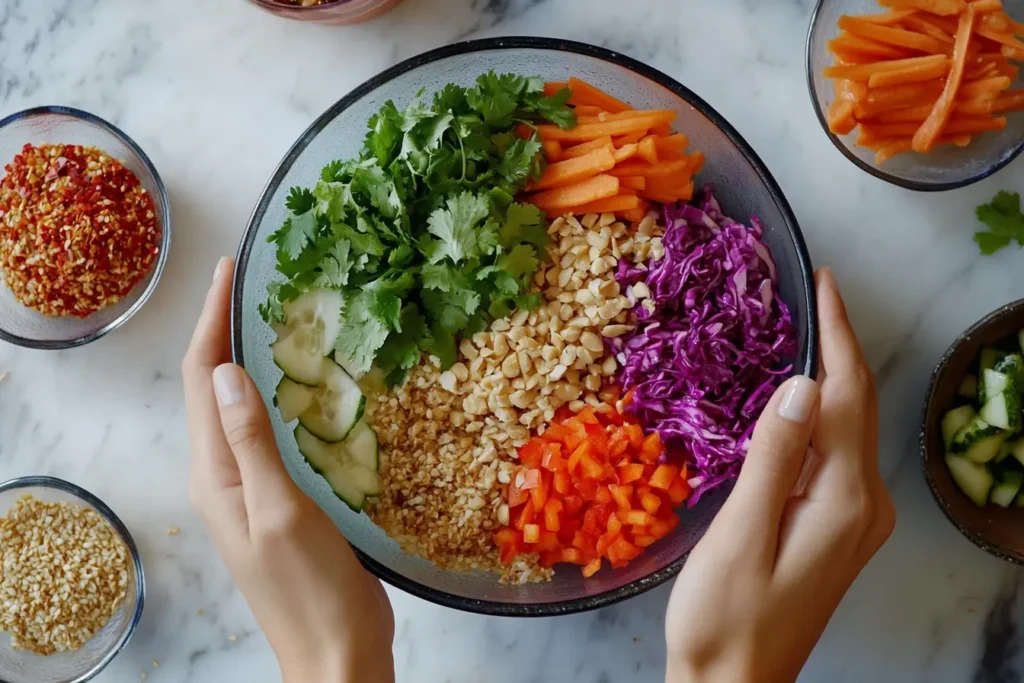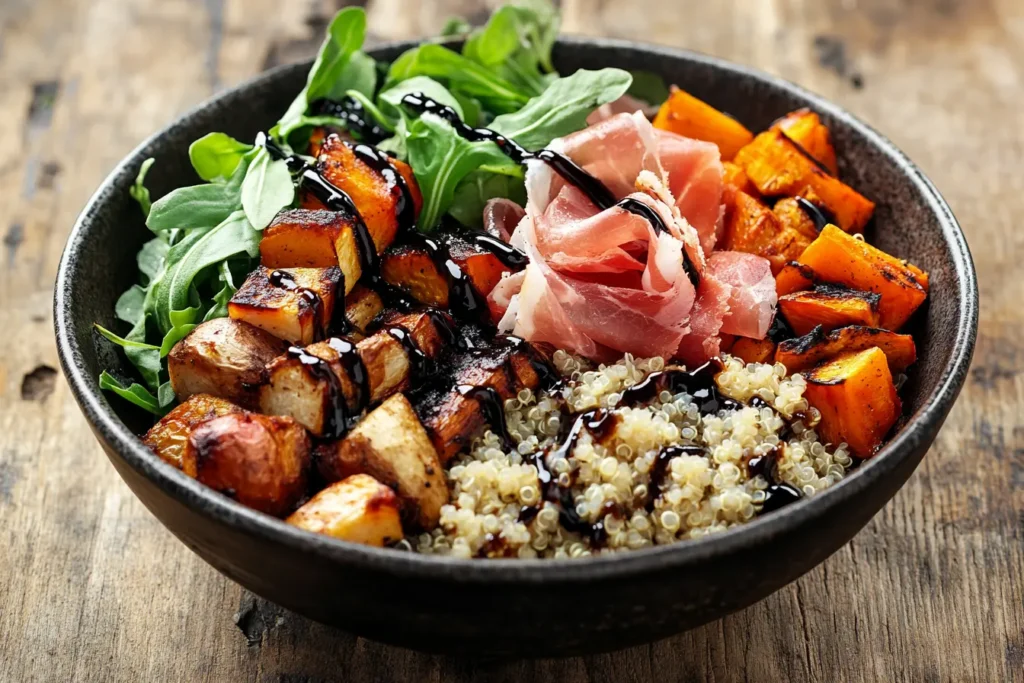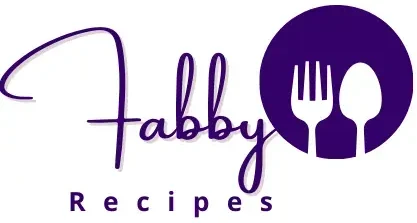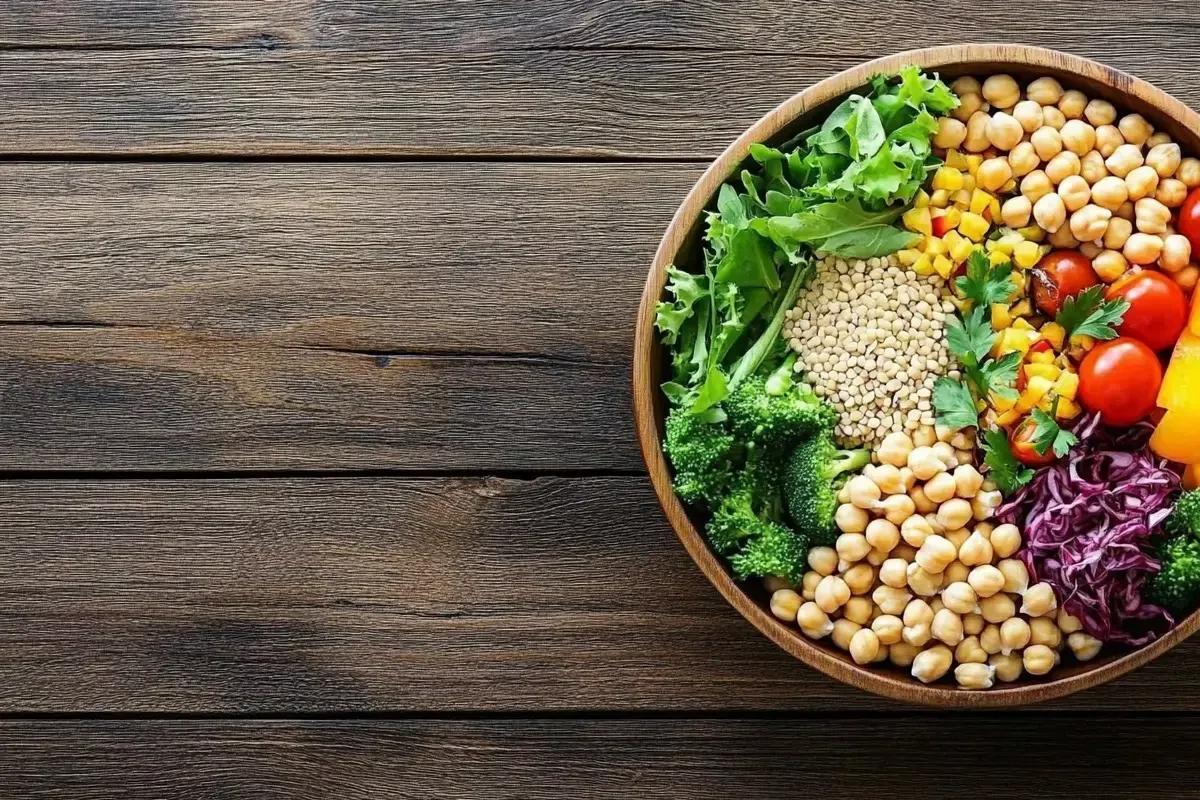A Buddha Bowl is a complete meal in one dish, offering a mix of flavors and textures. This article explores all aspects of crafting the perfect Buddha Bowl, from its elements to benefits. Learn how to make your own balanced meal.
What Exactly Is a Buddha Bowl?
The Buddha Bowl, also known as a nourish bowl, is a single-dish meal. It often includes grains, vegetables, proteins, and a dressing. These components create a balanced and satisfying meal. Therefore, many people enjoy the flexibility of this dish.
Origins of the Buddha Bowl
The name “Buddha Bowl” suggests a connection to Buddhism. However, its origins are not explicitly religious. Instead, the name refers to the rounded shape of the bowl. It is often full to the brim, resembling a Buddha’s belly. Accordingly, it implies fullness and satisfaction.
Why Buddha Bowls Are So Popular
Buddha Bowls have become very popular for several reasons. Firstly, they are easy to customize. Secondly, they are a convenient way to eat healthy. Additionally, they appeal to different dietary needs. Finally, they’re visually appealing, which enhances the overall dining experience.
The Key Components of a Buddha Bowl
A balanced Buddha Bowl includes several important parts. These parts work together to make a meal that is both healthy and tasty. Specifically, let’s look at each component.
The Base: Grains or Alternatives
The base of a Buddha Bowl is usually a grain. This might be brown rice, quinoa, or farro. However, you can also use sweet potatoes or roasted vegetables. Indeed, this provides a solid foundation for the bowl. Furthermore, it offers important carbohydrates for energy.
- Brown Rice
- Quinoa
- Farro
- Sweet Potatoes
- Roasted Vegetables
The Greens: Leafy and Nutritious
Leafy greens provide many nutrients in a Buddha Bowl. For example, spinach, kale, and romaine lettuce are great options. These are a source of fiber and vitamins. Therefore, including greens is essential for a healthy bowl. Moreover, they add texture and freshness.
- Spinach
- Kale
- Romaine Lettuce
- Arugula
- Mixed Greens
The Proteins: Building Blocks
Proteins are important for Buddha Bowls. They help with muscle growth and feeling full. Comparatively, plant-based proteins are ideal for vegetarians. Examples include chickpeas, tofu, and lentils. Similarly, those who eat meat might opt for chicken or fish. Thus, the choice of protein is very flexible.
- Chickpeas
- Tofu
- Lentils
- Black Beans
- Chicken
- Salmon
The Vegetables: Color and Flavor
Vegetables add color, flavor, and even more nutrients to your Buddha Bowl. For example, roasted vegetables like broccoli, carrots, and beets can be used. Also, fresh vegetables such as cucumber and tomatoes work well. Basically, the options are limitless when it comes to vegetables.
- Broccoli
- Carrots
- Beets
- Cucumber
- Tomatoes
- Bell Peppers
- Avocado
The Healthy Fats: Adding Creaminess
Healthy fats add flavor and help you feel full. Specifically, avocado, nuts, and seeds are good choices. Additionally, these fats are good for your heart and brain. Moreover, they add richness to the Buddha Bowl.
- Avocado
- Nuts (almonds, walnuts)
- Seeds (chia, sunflower)
- Olive Oil
- Tahini
The Dressing: Tying It All Together
The dressing brings all the flavors together. A simple vinaigrette, tahini sauce, or a lemon dressing are excellent choices. Also, consider the overall flavor of your Buddha Bowl when choosing a dressing. Undoubtedly, the dressing is vital to the overall taste.
- Vinaigrette
- Tahini Sauce
- Lemon Dressing
- Balsamic Glaze
- Peanut Sauce
How To Build a Perfect Buddha Bowl
Making a Buddha Bowl is easy. Firstly, choose your base, such as quinoa or rice. Secondly, add a generous helping of greens. Thirdly, add your chosen protein. Then, include vegetables for additional nutrients. Next, add healthy fats for flavor. Finally, drizzle with your chosen dressing.

Step-by-Step Guide
- Choose Your Base: Select grains or roasted vegetables.
- Add Greens: Pack the bowl with leafy greens.
- Select Protein: Add your protein source like chickpeas.
- Include Vegetables: Use a mix of fresh and roasted options.
- Incorporate Healthy Fats: Include nuts, seeds, or avocado.
- Drizzle Dressing: Complete the bowl with your favorite dressing.
Buddha Bowl Variations and Ideas
Buddha Bowls are very flexible, so try different variations. For example, you can try a Mediterranean Buddha Bowl with feta cheese, olives, and hummus. Alternatively, a Mexican Buddha Bowl with black beans, corn, and salsa is also an option. Accordingly, these bowls cater to many different tastes.
- Mediterranean Buddha Bowl
- Feta cheese
- Olives
- Hummus
- Mexican Buddha Bowl
- Black beans
- Corn
- Salsa
- Asian-inspired Buddha Bowl
- Edamame
- Sesame seeds
- Peanut sauce
- Fall-Inspired Buddha Bowl
- Roasted Butternut Squash
- Cranberries
- Pecans
Health Benefits of Buddha Bowls
Buddha Bowls are not only tasty but also good for your health. Specifically, the combination of nutrients makes them a very healthy meal. Furthermore, they can help with digestion and overall well-being.
Rich in Nutrients
- Buddha Bowls are full of essentialnutrients.
- They include vitamins and minerals from vegetables.
- They include protein from legumes or meats.
- They include healthy fats from avocado and nuts.
Good for Digestion
The fiber in grains and vegetables helps with digestion. Therefore, eating Buddha Bowls can promote a healthy gut. Indeed, a balanced gut is important for overall health. In addition, probiotics can contribute further to gut health if you use fermented foods as a component.
Promotes Feeling Full
Buddha Bowls are very satisfying. Specifically, they have a good mix of fiber, protein, and healthy fats. Consequently, they can help you feel full for longer, helping with weight management. Additionally, feeling full can avoid unhealthy snacking.
Adaptable to Dietary Needs
Buddha Bowls are also compatible with various diets. For example, they can be gluten-free by using quinoa as a base. Similarly, they can be lactose-free by avoiding dairy-based dressings. Moreover, they are perfect for vegetarians and vegans. Thus, they are very flexible for various dietary requirements.
A Source of Antioxidants
The varied colors of vegetables in a Buddha Bowl indicate a high antioxidant content. Consequently, they help fight cell damage in the body. Indeed, antioxidants contribute to overall health and wellness. Moreover, they promote healthy aging.
Buddha Bowl Recipes: Getting Started
Getting started with making your own Buddha Bowl is easy. However, it might be helpful to have a basic recipe to follow. Therefore, here is a simple recipe to get you started.
Simple Buddha Bowl Recipe
Ingredients:
- 1 cup cooked quinoa
- 2 cups spinach
- 1 can chickpeas, rinsed
- 1 cucumber, sliced
- 1 tomato, diced
- 1/2 avocado, sliced
- 2 tablespoons tahini dressing
Instructions:
- Place cooked quinoa in a bowl.
- Add spinach.
- Top with chickpeas, sliced cucumber, and diced tomato.
- Add sliced avocado.
- Drizzle with tahini dressing.
- Enjoy your Buddha Bowl immediately.
Buddha Bowl Sauce Options
The dressing is a key part of a Buddha Bowl. Furthermore, the dressing brings out the flavors of the bowl. Hence, here are a few sauce ideas.
- Tahini Dressing: Mix tahini, lemon juice, water, and garlic.
- Lemon Vinaigrette: Combine olive oil, lemon juice, and herbs.
- Peanut Sauce: Mix peanut butter, soy sauce, honey, and lime juice.
- Balsamic Glaze: Drizzle over the bowl for a tangy flavor.
How to Make Your Buddha Bowl Even Better
There are a few ways to make your Buddha Bowl even better. Specifically, consider the textures and colors of your ingredients. Furthermore, use fresh, high-quality components to elevate the dish.
Tips for Perfect Buddha Bowls
- Color Variety: Use vegetables of various colors.
- Texture Contrast: Combine soft and crunchy components.
- Freshness: Use fresh ingredients whenever possible.
- Flavor Balance: Make sure your sauce compliments the other components.
- Layer Components: Arrange your ingredients for visual appeal.
Serving Suggestions
Buddha Bowls can be enjoyed as a light lunch or a substantial dinner. Moreover, they can be packed for lunch for an easy and healthy meal. Additionally, they can be adjusted to suit different preferences. Therefore, they are ideal for a quick and complete meal, and if you’re looking for another easy way to balance out a meal consider our Pizza Night Salad: The Perfect Companion for a Balanced Meal.
Buddha Bowls for Special Diets
As previously mentioned, Buddha Bowls are perfect for many diets. Therefore, let’s look at how they can be used for various dietary needs.
Gluten-Free Buddha Bowls
To create a gluten-free Buddha Bowl, choose a gluten-free base. For example, quinoa, rice, or sweet potatoes are good options. Additionally, make sure your dressings are also gluten-free. Consequently, you can enjoy a healthy, gluten-free meal.
Vegetarian and Vegan Buddha Bowls
Buddha Bowls are often vegetarian and vegan. However, ensure that you are using plant-based proteins. Moreover, there are many variations that suit vegetarians. Specifically, try using tofu, lentils, or chickpeas. Consequently, you can enjoy a delicious and plant-based meal.
Low-Carb Buddha Bowls
If you are limiting carbohydrates, you can still enjoy a Buddha Bowl. For example, you can use cauliflower rice or extra vegetables as a base. In addition, focus on including enough protein and healthy fats. Accordingly, you can create a low carb bowl that is still satisfying.
Exploring Additional Buddha Bowl Enhancements
Beyond the core ingredients, there are many other ways to boost your Buddha Bowl. These enhancements can add new layers of flavor and nutrients. Moreover, these additions can elevate your overall culinary experience.

The Power of Pickled Vegetables
Pickled vegetables offer a tangy and slightly sour element to the Buddha Bowl. For instance, pickled red onions, carrots, or cucumber can compliment the other ingredients. Further, these pickled vegetables also add a unique crunch. Therefore, they provide an interesting textural contrast.
Adding Spices and Herbs
Spices and herbs can greatly enhance the flavor of your Buddha Bowl. For example, sprinkling some chili flakes can add a bit of heat. Additionally, fresh herbs like cilantro or parsley can boost the freshness. Consequently, experimenting with spices and herbs is an easy way to add more flavor.
Roasted Components for Depth
Roasting vegetables and proteins adds a deeper, richer flavor to a Buddha Bowl. For example, roasted sweet potatoes or broccoli can offer a smoky taste. Thus, roasting can make these components more indulgent. Accordingly, this method can enhance the overall taste.
The Art of Sprinkling Seeds
Sprinkling seeds, like sunflower, sesame, or pumpkin, adds not only nutrients but also texture. Specifically, these seeds offer a pleasant crunch. Moreover, they provide an added dose of healthy fats. Furthermore, seeds also contribute to the visual appeal of the Buddha Bowl.
Fermented Foods for Gut Health
Including fermented foods, like kimchi or sauerkraut, can add a tangy flavor. Additionally, they also support good gut health. Indeed, these foods contain probiotics which aids digestion. Therefore, they are a great addition for anyone looking to improve their digestive health.
Buddha Bowls and Meal Prepping
Buddha Bowls are ideal for meal prepping due to their versatility. You can prepare ingredients in advance and assemble them when needed. Therefore, this makes them perfect for busy weeks. Consequently, you can ensure a healthy meal throughout the week.
Preparing Buddha Bowl Components
- Grains: Cook your grains in large batches and store them in the fridge.
- Vegetables: Chop and roast your vegetables ahead of time.
- Proteins: Cook your proteins and store them separately.
- Dressings: Make your dressings and keep them in airtight containers.
Assembling Buddha Bowls for the Week
With the components prepared, assembling a Buddha Bowl is very easy. Firstly, divide the components into individual containers. Secondly, add your chosen dressing just before serving. Finally, you have a quick, healthy, and satisfying meal ready whenever you need it.
Tips for Meal Prepping Buddha Bowls
- Store components separately: This avoids soggy vegetables.
- Use airtight containers: Maintain freshness and avoid leaks.
- Prepare a variety: To keep your meals interesting, prepare different variations.
- Adjust portion sizes: To suit your dietary needs, adjust portions as necessary.
- Label containers: Make it easy to identify and track your prepared components.
Buddha Bowl Nutritional Information
Understanding the nutritional value of your Buddha Bowl is very important. However, it can change based on the exact ingredients. Therefore, here is a general overview of the nutritional content. This is a sample calculation and will change depending on your ingredients.
| Nutrient | Amount per Serving (approximate) |
| Calories | 400-600 |
| Protein | 15-25g |
| Fat | 20-30g |
| Carbohydrates | 40-60g |
| Fiber | 10-15g |
| Vitamins | High (depending on vegetables) |
| Minerals | High (depending on vegetables) |
Customizing Your Buddha Bowl Experience
The beauty of Buddha Bowls lies in their flexibility. You can adapt them to suit your personal preferences. Therefore, let’s examine how to further customize the Buddha Bowl experience.
Choosing Ingredients Based on Season
- Spring: Feature fresh greens and radishes.
- Summer: Use ripe tomatoes, cucumber, and corn.
- Fall: Incorporate squash and apples.
- Winter: Choose hearty greens and root vegetables.
Adapting to Cultural Flavors
- Mediterranean: Use olives, feta, and hummus.
- Asian: Use edamame, sesame, and ginger.
- Mexican: Use black beans, salsa, and avocado.
Creating a Buddha Bowl Around Specific Proteins
- Tofu: Marinate before adding to the bowl.
- Chicken: Grill or bake for the best flavor.
- Lentils: Use them as a hearty protein-rich base.
Tailoring to Specific Nutrient Needs
- Boost protein: Add extra proteins like nuts and seeds.
- Increase fiber: Use more vegetables and whole grains.
- Include healthy fats: Add avocado and nut butters.
The Buddha Bowl: A Culinary Journey
The Buddha Bowl is more than just a meal. It’s a way to explore different flavors and textures. Further, it is a way to experiment with various ingredients. Therefore, each bowl can be a different culinary experience, tailored to your individual preferences.

